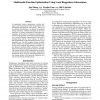Free Online Productivity Tools
i2Speak
i2Symbol
i2OCR
iTex2Img
iWeb2Print
iWeb2Shot
i2Type
iPdf2Split
iPdf2Merge
i2Bopomofo
i2Arabic
i2Style
i2Image
i2PDF
iLatex2Rtf
Sci2ools
134
Voted
FLAIRS
2004
2004
Multimodal Function Optimization Using Local Ruggedness Information
In multimodal function optimization, niching techniques create diversification within the population, thus encouraging heterogeneous convergence. The key to the effective diversification is to identify the similarity among individuals. Without knowledge of the fitness landscape, it is usually determined by uninformative assumptions. In this article, we propose a method to estimate the sharing distance for niching and the population size. Using the Probably Approximately Correct (PAC) learning theory and the -cover concept, we prove a PAC neighborhood of a local optimum exists for a given population size. The PAC neighbor distance is further derived. Within this neighborbood, we uniformly sample the fitness landscape and compute its subspace fitness distance correlation (FDC) coefficients. An algorithm for estimating the granularity feature is described. The sharing distance and the population size are determined when above procedure converges. Experiments demonstrate that by using the...
Related Content
| Added | 30 Oct 2010 |
| Updated | 30 Oct 2010 |
| Type | Conference |
| Year | 2004 |
| Where | FLAIRS |
| Authors | Jian Zhang 0007, Xiaohui Yuan, Bill P. Buckles |
Comments (0)

